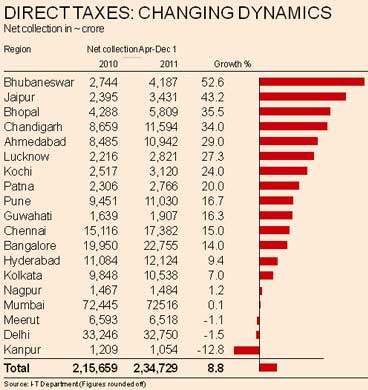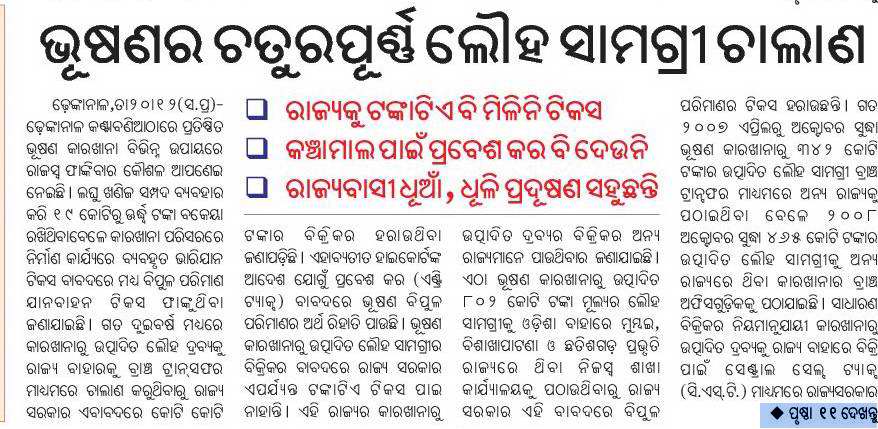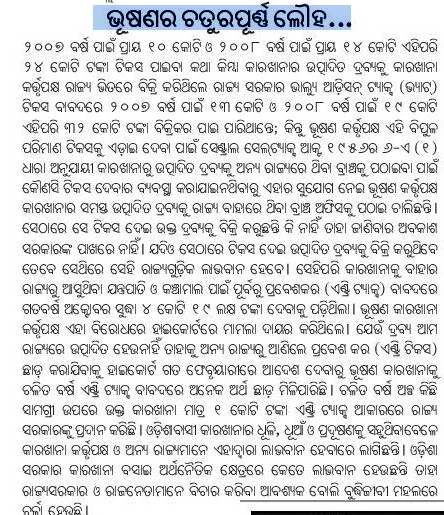I came across a 1-page note someone from POSCO-India gave me when I was visiting Bhubaneswar in December 2006-Jan 2007. The 1-page note summarizes a study done by NCAER. The study has also been reported in News media such as Hindu Businessline. (POSCO-India in its web page has additional links.) We will give some excerpts from the Hindu Businessline report.
The 1-page note: POSCO-India’s rs 52,810 Cr investment by 2016 will stimulate Orissa Economy.
- Economic Benefit:
- Generate Rs 29,760 crores additional annual gross output for Orissa including Rs 12,610 Crore of POSCO-India’s direct gross output.
- Create excess annual value addition of Rs. 12,100 crores for Orissa which equals 19% of Orissa’s state GDP in 2005-06 (equals 11.5% in 2016-17)
- Employment:
- Job creation of 870,000 man years, absorbs 88% of state unemployment backlog (i.e., decrease in backlog of employment from 9.9 lakhs in 2005-06 to 1.2 lakhs).
- 18,000 man years of direct employment in POSCO-India.
- Tax Contribution:
- POSCO-India annual tax contribution (Rs 2,620 Crores) would be appx. 17.6% of total tax revenue of Govt. of Orissa in 2016-17.
- POSCO-India SEZ would contribute Rs 174,970 crore tax revenue in next 35 years.
- Rs 77,870 crores would be to Govt. of Orissa and Rs 97,100 crores to Govt. of India.
- The differences of tax between SEZ and DTA status is less than 8% for Govt. of Orissa and 5% for Govt. of India.
- Comparison with current Orissa Economy:
- Orissa in 2003-04:
- Gross Output: 111,378 crores
- State GDP: 53,830 crores
- Employment: 143 lakhs (2001 census)
- Tax: 8170 crores (2005-06)
- POSCO-India’s impact:
- Gross Output: 29,760 crores
- State GDP: 12,100 crores
- Employment: 8.7 lakhs
- Tax: 2620 crores
We now give some excerpts from the Hindu Business line article of January 2007 which partly explains how some of the above numbers were calculated. That article was written by R. Venkatesan who works for NCAER, but the article was his personal view.
The NCAER study broadly used the ADB/World Bank methodology on the social cost-benefit with minor adjustments for the local parameters. Econometric models were used to project border prices for the useful life of the project. The project’s impact from the State economy perspective — in terms of the impact on the State GDP (output multiplier effects) and employment opportunities created within the State (employment multiplier effects) was also assessed.
The output multiplier for iron ore was found to be 1.4 compared to 2.36 for steel. In other words, every Rs 1 lakh worth of output in the iron ore sector would result in Rs 1.4 lakh of output (including the Rs 1 lakh output of iron ore) compared to Rs 2.36 lakh for every Rs 1 lakh output of steel. The employment multipliers for iron ore and steel work out to 0.35 and 0.69 man-years respectively. Therefore, in terms of both output and employment, steel has a larger impact.
These multipliers imply that the Posco project would create an additional employment of 50,000 person years annually for the next 30 years vis-à-vis 870,000 person years in the steel project alternative. In terms of value addition, the iron ore and steel project alternatives would contribute 1.3 per cent and 11.5 per cent to Orissa’s State Gross Domestic Product (or SGDP) by 2016-17 respectively.
An important part of the study was the Least Cost Analysis of technology options in the steel-making, the Finex process that Posco purports to bring and the traditional blast-furnace technology. The Average Incremental Economic Cost was used as the yardstick; this was followed by computing the economic IRR (internal rate of return)
to examine whether the project was economically worthwhile from the national economy point of view.
The EIRR for the Orissa project works out to 16.6 per cent for base case and even in the worst case scenario, the EIRR at 13.9 per cent would remain above the hurdle rate of 12 per cent. The economic impact of the project was estimated at $2.5 billion at the test discount rate of 12 per cent.
The significant feature of the study was the estimation of depletion premium or the opportunity cost for depleteable and non-renewable resource iron ore for reasons cited below:
India’s high-grade ore (+ 65 per cent Fe content — Haematite) reserves, proven and probable, amount to only 0.58 billion tonnes. And even if we were to factor in indicative and inferred reserves (probable/feasible), the total reserves (proven and possibly future potential) would be only 0.92 billion tonnes.
India’s medium-grade ore (+62 per cent Fe to 65 per cent Fe — Haematite) reserves, proven and probable, is only 1.3 billion tonnes. Here too, if we factor in indicative and inferred (probable/feasible and pre-feasibility estimated) reserves, the total reserves (proven and possibly future potential) will be only 2.8 billion tonnes.
Policy Implications
Orissa stands to gain significantly if instead of exporting iron ore it processes it to steel within the State, in terms of both employment generation (17 times), and GDP impact (9 times).
India’s high and medium grade iron ore reserves may not last more than 19 years even if exports of these grades are frozen at the current level or if the targets set out in the draft steel policy are to be met. The economic analysis considered the depletion premium for high and medium grade iron ore. This is the opportunity cost to the national economy of using the depletable resource, which is the average incremental cost of depletion premiums computed year-wise.
Any exporter of iron ore of medium and high grades from the State needs to pay a depletion premium of $27 per tonne. Even this would be a sub-optimal policy from the State’s viewpoint if it can process the medium and high grade ore to steel. No such depletion premium has been applied for coking coal as its price did not exhibit any
trend before the recent steep price hike.
For the eastern States seeking to raise the mineral sector’s share in their GDP, it may be a good idea to set up processing facilities. It would not be advisable to allocate iron ore mines through open bids or accept increased royalty payments, even accounting for the depletion premium, compared to the option of processing iron ore to steel. Future cost-competitiveness and logistical advantage imply that iron ore-rich States can compete with existing over-capacities in the US, Europe and Japan even after factoring in the capital charges for new investments.
Export of iron ore needs to be restricted to grades other than medium and high-grade ore categories; for instance, export of beneficiated ore from Goa using inland waterways logistics advantages could be encouraged. Allowing exports of high grade ore would facilitate export of steel from existing over-capacities in the US, Europe and Japan to East Asia at the expense of future steel exports from new Indian steel capacities which are likely to enjoy cost-competitiveness over existing over-capacities elsewhere.
I am not qualified to judge the above analysis. I would appreciate any comments, analysis, criticisms etc. on the above.



